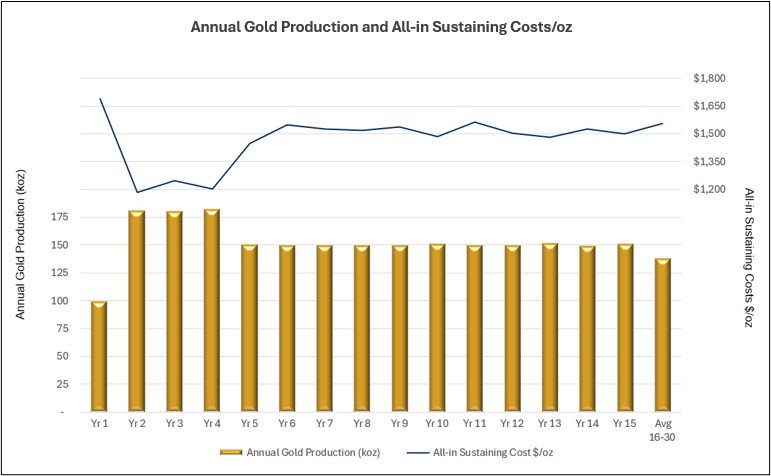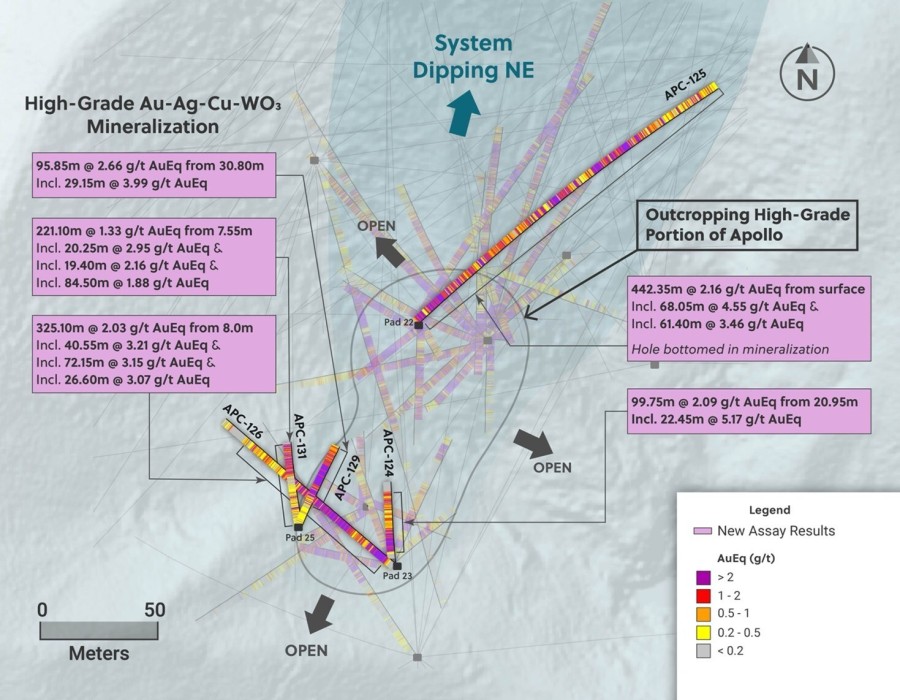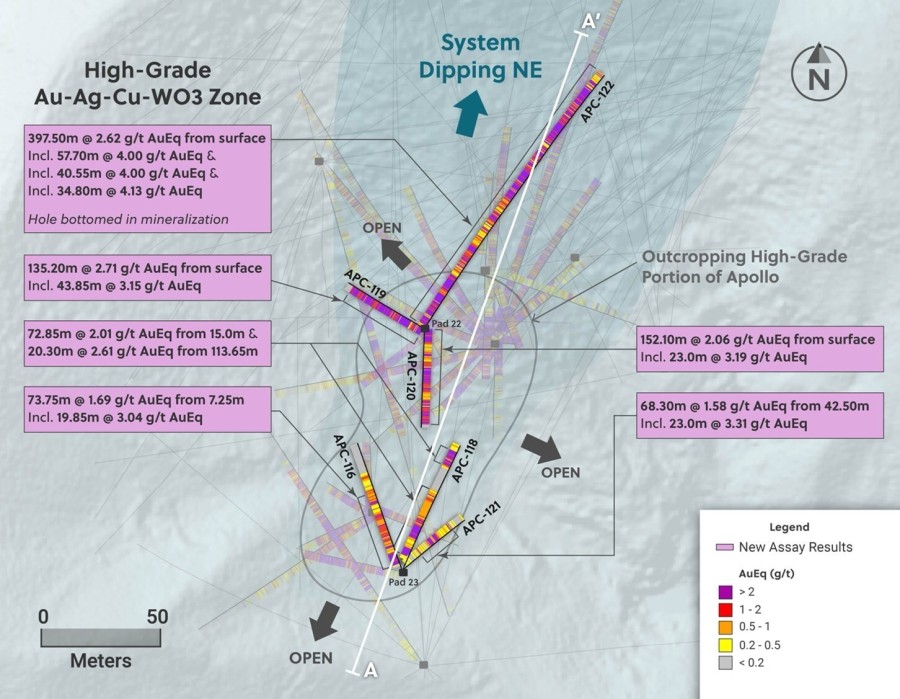TORONTO, Nov. 16, 2017 /CNW/ - Rubicon Minerals Corporation (TSX: RMX | OTCQX: RBYCF) ("Rubicon" or the "Company") provides an update of its 2017 Exploration Program at the Phoenix Gold Project with additional drill results and observations and announces that it has commenced exploratory underground development.
Assay Results Highlights (as of November 16, 2017) representing approximately 4,500 metres ("m") of drilling:
Infill and step-out drilling program at the 305-, 610-, and 685-metre levels – with the objective of potentially upgrading and growing the 2016 Mineral Resources ("Mineral Resources")(not true widths, more details in the 'Qualified Persons and QA/QC' section below):
- 305-17-21: 11.06 grams per tonne of gold ("g/t Au") over 3.6 m (including 20.80 g/t Au over 1.6 m) and 10.12 g/t Au over 3.1 m (including 16.54 g/t Au over 1.2 m)
- 305-17-29: 5.24 g/t Au over 6.0 m (including 7.82 g/t Au over 2.0 m)
- 610-17-18: 10.04 g/t Au over 3.1 m (including 16.82 g/t Au over 1.8 m)
- 610-17-19: 14.30 g/t Au over 7.7 m (including 21.43 g/t Au over 4.8 m)
- 610-17-21: 7.24 g/t Au over 4.0 m
2017 Exploration Program Update
The Company completed all of its planned 23,500 m of drilling in October 2017. Rubicon is currently awaiting assay results from the final 4,592 m of drilling (approximately 1,375 assays) that were submitted to a third-party assay lab. The Rubicon team, together with Golder Associates Inc. ("Golder") and T. Maunula & Associates Consulting Inc. ("Maunula Associates"), is continuing to evaluate the data with the objective of updating the geological model for the F2 Gold Deposit. Rubicon and its consultants are currently analyzing the structural data to determine the relationship between the structures, the lithology, and the gold mineralization at the deposit. The Company and its consultants anticipate being able to comment on the structural geology of the F2 Gold Deposit following the return of all the outstanding assays.
The Company commenced exploratory underground development at the Phoenix Gold Project, which will continue through to the first half of 2018. Once enough trial stoping blocks have been opened, the Company will move into a test mining phase. Details of the 2018 test mining plans will be forthcoming in a future news release in early 2018. Rubicon remains on schedule to deliver an NI 43-101 Technical Report and updated Mineral Resource Estimate in the second half of 2018.
Golder is conducting test modelling to improve the representativeness of the geological model but it is uncertain at this time what impact the re-interpretation will have on the Mineral Resource Estimate. In addition, Maunula Associates will continue to act as a third-party independent consultant who will conduct a peer review at key milestones throughout the exploration program.
Golder has completed numerous Qualified Person (QP) site visits at the Phoenix Gold Project and has concluded that the geological and analytical procedures put in place by Rubicon for the 2017 Exploration Program are consistent with standard industry practises and that the data is of sufficient quality to support the ongoing Mineral Resource modelling.
Summary Assay Results and Diagrams
At the end of the news release, readers will find the following:
- Table 1: Summary of 2017 Drilling Assay Results, up to November 16, 2017
- Diagrams 1-5: Infill and step-out drilling at the 305-metre level, plan and section views.
- Diagrams 6-9: Infill and step-out drilling at the 610-metre level, plan and section views.
- Diagrams 10-11: Infill and step-out drilling at the 685-metre level, plan and section views.
Please see our news release on September 18, 2017 for previously released assay results and diagrams from the 2017 Exploration Program.
Additional Observations up to November 16, 2017
The Rubicon team and its consultants have produced additional observations from the 2017 Exploration Program. Readers are cautioned that these observations could change as the Company advances its exploration activities. Rubicon believes there is inadequate information at this time to provide interpretations on an updated geological model and to update the Mineral Resources for the F2 Gold Deposit. The following are some of the additional observations:
- More high-grade gold intercepts encountered from flat-angled drilling at the 610-metre level: Rubicon continues to encounter higher-grade gold intercepts at the deeper portions of the F2 Gold Deposit (from 488-metre level and below), as displayed in Diagrams 7, 8 and 9.
- Many gold intercepts continue to be of higher-grade compared to the 2016 Mineral Resource block model: The Company continues to encounter drill hole composite grades that are higher than the 2016 Mineral Resource block model, as displayed in Diagrams 2 to 5, 7 to 9, and 11. Rubicon has also encountered gold mineralization in areas outside of the 2016 Mineral Resource block model, as displayed in Diagrams 2, 4, 5, 8 and 9.
The Company intends to provide periodic updates as it completes the various elements and analysis of the exploration program.
CEO's Comments
Rubicon President and Chief Executive Officer George Ogilvie, P.Eng., stated "We are further encouraged by the data that we have gathered from the completed 23,500-metre drill program. We continue to see assay grades that, in most instances, are higher compared to the 2016 Mineral Resource block model. Generally, we are observing higher gold grade composites at the deeper portions of the F2 Gold Deposit compared to the composites in the upper portions. These recent observations appear to support historical drilling results, where we have also encountered higher gold grades from deeper drilling. Given the encouraging results from the deeper drilling and that we are under budget and on schedule with our plans, we have elected to drill an additional 5,000 m from the 610- and 685-metre levels before year-end."
"Over the next few weeks, we anticipate the receipt of all our outstanding assay results from our original 23,500-metre drill campaign, initial commentary on the structural geology of the F2 Gold Deposit, and further details on our exploratory underground development and test mining plans. We plan to provide an update to the markets in due course."
Qualified Persons and QA/QC
The content of this news release has been read and approved by George Ogilvie, P.Eng., President and CEO, and Mark Ross, B.Sc., P.Geo., Chief Mine Geologist, for Rubicon. Both are Qualified Persons as defined by NI 43-101.
Underground drilling was conducted by Boart Longyear Drilling of Haileybury, Ontario and was supervised by the Rubicon exploration team. All assays reported are uncut unless otherwise stated. All samples reported herein were performed by SGS Mineral Services of Red Lake, Ontario. All NQ core assays reported were obtained by fire assay with AA-finish or using gravimetric finish for values over 10.0 g/t Au.
Intercepts cited do not necessarily represent true widths, unless otherwise noted, however drilling is generally intersecting interpreted mineralized zones at a high angle. True width determinations are estimated at 65-80% of the core length intervals for the 305-metre level drilling, and estimated at 75-95% of the core length for the 610- and 685-metre level drilling. Rubicon's quality control checks include insertion of blanks, standards and duplicates to ensure laboratory accuracy and precision.
About Rubicon Minerals Corporation
Rubicon Minerals Corporation is an advanced gold exploration company that owns the Phoenix Gold Project, located in the prolific Red Lake gold district in northwestern Ontario, Canada. Additionally, Rubicon controls over 280 square kilometres of prime exploration ground in Red Lake and more than 900 square kilometres of mineral property interests in the emerging Long Canyon gold district that straddles the Nevada-Utah border in the United States. Rubicon's shares are listed on the Toronto Stock Exchange (RMX) and the OTCQX markets (RBYCF). For more information, please visit our website at www.rubiconminerals.com.





